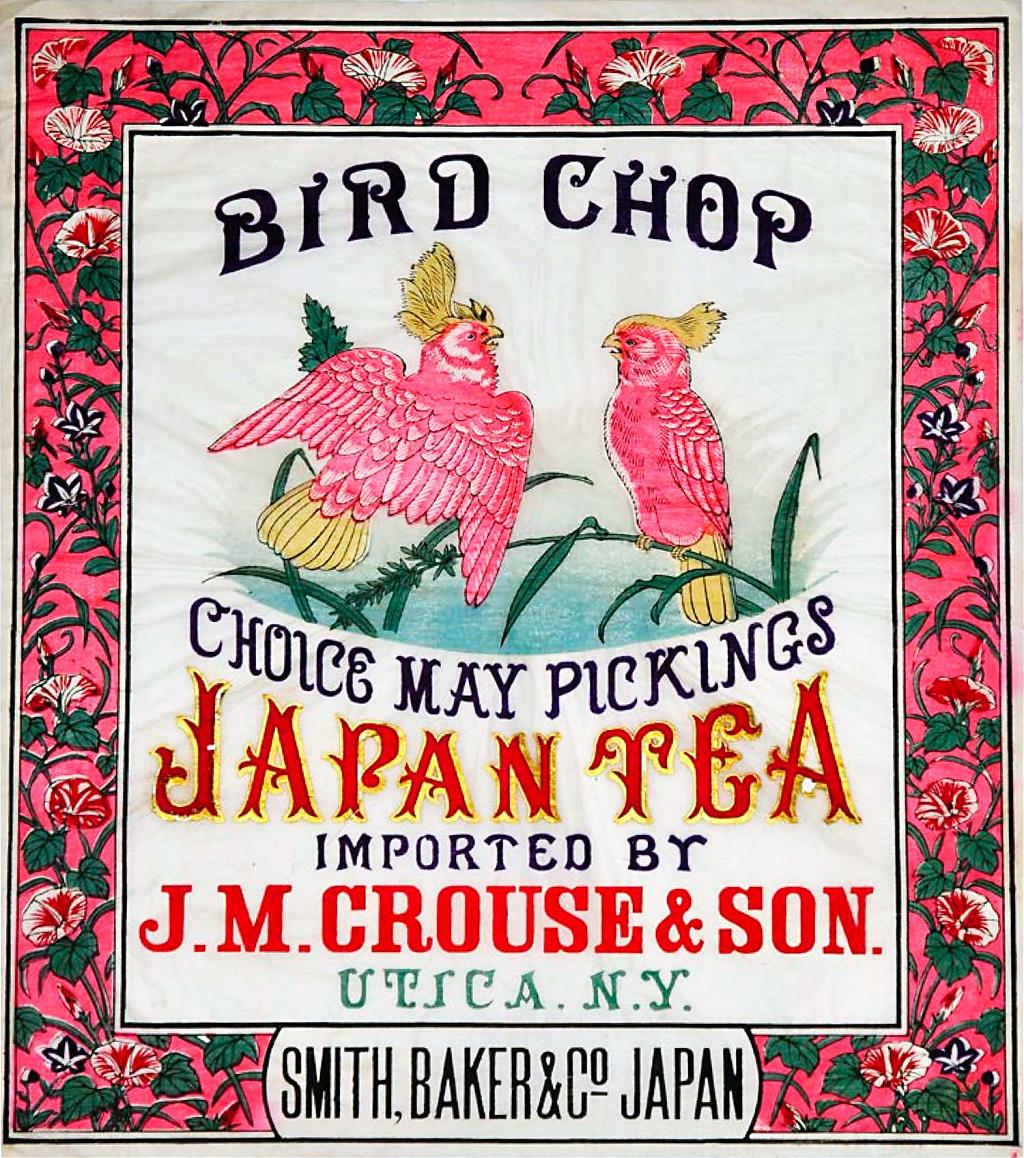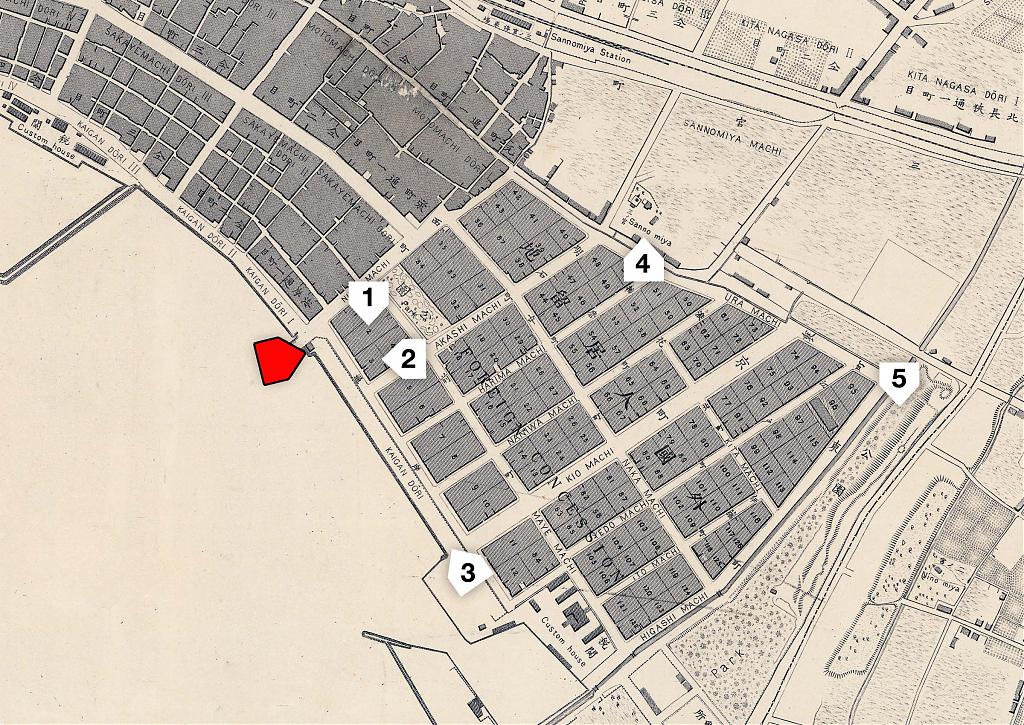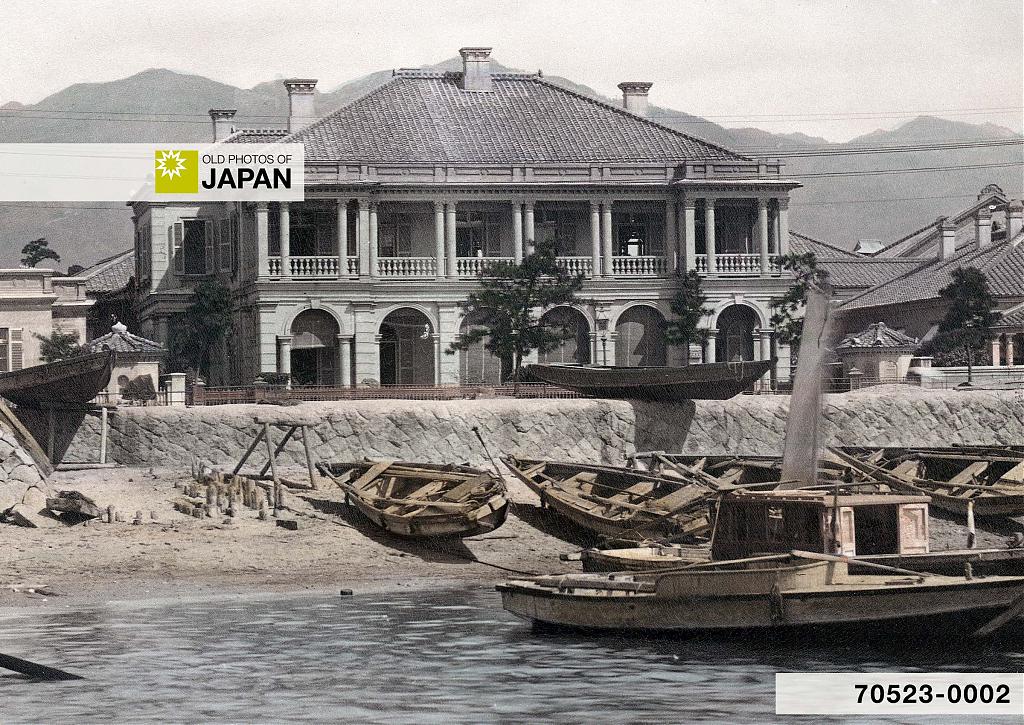A quiet day on the Bund of Kobe. Fishermen are working in their boats moored on a sandy beach in front of the sea wall.
The big building in the middle is the office of Walsh, Hall & Co., located at No. 2. Founded in 1868 (Keio 4) by American trader John Walsh and his brother, the company owned a paper mill in Sannomiya that would grow into the Mitsubishi Paper Mills. No. 2 was later sold to the Hongkong and Shanghai Bank.
On the far right are the offices of the tea exporter Smith, Baker & Co., located at No.3. After Japan was opened for trade in the mid 19th century, tea became one of the country’s main exports. Smith, Baker & Co., founded in Yokohama around 18591, was one of its largest exporters.

The photo was taken from American Hatoba, the pier through which once all visitors entered Kobe. It is now an invisible part of Meriken Park.

When Kobe, or Hiogo as it was still called in those days, was opened to foreign trade on New Year’s Day 1868, there was nothing but a barren sandy area that was flooded during heavy storms. Difficult to imagine now, as today it is all concrete and asphalt, but fishermen used to haul nets of iwashi (sardines) here on beautiful beaches.
Harold Williams beautifully describes the impression of the first settlers in his Tales of the Foreign Settlements in Japan2:
The merchants aboard their vessels were gazing at the sandy waste that was to be their home, and at the long sandy beach, lined for most of the way with old gnarled pine trees, that stretched towards Osaka. They were contemplating with some misgivings the intense amount of work that would have to be undertaken to raise the level of their settlement, to make it safe from invasion by the sea during typhoons, and to turn a barren sandy waste into a mercantile centre. As the merchants awaited their appointed hour of landing, their thoughts turned to the problem of accommodation. To the east of their future settlement, towards Osaka, there were mostly fields. To the west the straggling village of Kobe, a few sake breweries and godowns, and some straw-thatched fishing huts. Motomachi was a narrow and odiriferous street inches deep in mud and lined with poor mean buildings. Above the village towards the hills a few temples were seen, each set in its own forest of trees.

Because water flowed down from the mountains as well, the area was waterlogged and full of quicksand. On this improbable location, the English civil engineer John William Hart eventually built an elegant European style settlement, with roads, gas lamps, brick sewers and parks.
He, and the foreign community that settled in his town, did a wonderful job. Soon Kobe was referred to as the Model Settlement of the Far East, far more relaxed and safe than Yokohama, where during the first years after it was opened to trade, a long string of fear-inspiring murders took place. One multiple murder, the Namamugi Incident, even resulted in the bombardment of Kagoshima in 1863.
Kobe experienced two scares in 1868. On February 4, samurai from Bizen (today part of Okayama Prefecture) clashed with foreigners. Although nobody was killed, the foreign settlement was in a state of siege for several days. The worst incident happened a month later when 11 French sailors were killed in Sakai, on the other side of Osaka Bay. After that, Kobe quieted down and it remained that way.
When the first land sales were held in Kobe, the most popular lots were the ones along the beach. Gorgeous houses and offices with a fantastic view on the bay were built here. It didn’t take long before the Bund became an attractive promenade where curious Japanese watched Western families in their exotic clothing take walks and listen to the music played by Portuguese amateur bands or bands from visiting warships.3
Many of the Hongs (trading houses) had their compounds on the Bund. From their offices and storehouses wafted smells of tea, spices and silk-waste.4 Japanese, Chinese and Western employees, speaking myriad languages, walked in and out. Goods were delivered by handcars or were taken to tall ships from the West. Countless small Japanese boats maneuvered through the harbor. The views, the smells, the sounds. They all blended together into something unique that could only be found in the foreign concession. It was undoubtedly an exotic place to visit.
During the 1920s, the seawall was torn down, part of the harbor reclaimed and the street widened. Over the years more reclamation and construction followed. The former Bund is now far removed from the sea, and the once beautiful view on the bay is today obstructed by buildings and elevated highways.

First Auction Results
The first lots of the Kobe Foreign Settlement were sold at auction on September 10, 1868. The auction was attended by all foreign consuls, most of the foreign community of the new settlement, as well as Governor Hirobumi Ito (伊藤 博文, 1841–1909) and other Japanese officials.
Lot numbers 1 through 73 were offered; 37 of these were sold at a total price of 165,105 bu, then equivalent to 55,035 Mexican silver dollars.
The table below shows the winning bidders for the lots along the Bund.5
| 1 | Aspinall Cornes & Co. |
|---|---|
| 2 | Walsh, Hall & Co. |
| 3 | Smith, Baker & Co. |
| 4 | Smith, Baker & Co. |
| 5 | Nederlandsche Handel-Maatschappij (Netherlands Trading Society) |
| 6 | Adrian & Co. |
| 7 | F. Blake esq. |
| 8 | Schultze, Reis & Co. |
| 9 | Textor & Co. |
| 10 | Gutschow & Co. |
| 11 | Glover & Co. |
| 12 | Louis Kniffler & Co. |
Notes
1 Ukers, William H. (1935). All About Tea, Volume 2. New York, The Tea and coffee trade journal company, 223.
2 Williams, Harold S. (1958). Tales of the Foreign Settlements in Japan. Charles E. Tuttle Co., Inc., 65. ISBN 0804810516
3 ibid, 84-91.
4 ibid, 180-183.
5 The Japan Gazette, September 25, 1868.
Published
Updated
Reader Supported
Old Photos of Japan aims to be your personal museum for Japan's visual heritage and to bring the experiences of everyday life in old Japan to you.
To enhance our understanding of Japanese culture and society I track down, acquire, archive, and research images of everyday life, and give them context.
I share what I have found for free on this site, without ads or selling your data.
Your support helps me to continue doing so, and ensures that this exceptional visual heritage will not be lost and forgotten.
Thank you,
Kjeld Duits
Reference for Citations
Duits, Kjeld (). Kobe 1880s: Houses at the Bund, OLD PHOTOS of JAPAN. Retrieved on October 26, 2025 (GMT) from https://www.oldphotosjapan.com/photos/293/houses-at-bund




There are currently no comments on this article.